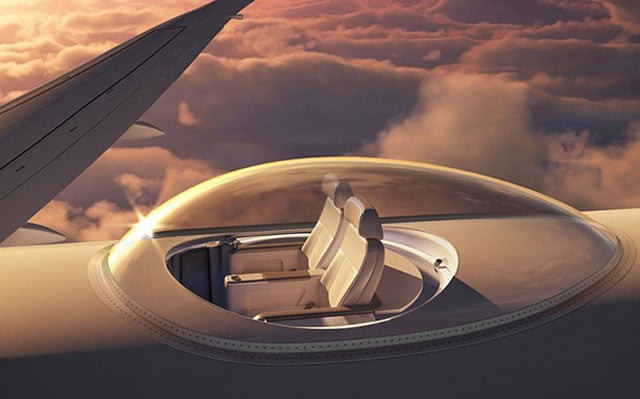Futuristic glass SkyDeck will offer passengers incredible 360° views from flight
The bubble pod would become an exclusive feature on commercial airliners

PHOTO: TELEGRAPH
The SkyDeck, devised by Washington-based Windspeed Technologies, is a futuristic bubble pod that would be added to the roof of a private jet or to some commercial airliners providing passengers with panoramic views of the world.
Boeing reveals world's largest airplane
The bubble pod would become a luxury feature for the rich and famous, or an exclusive feature on commercial airliners which would charge passengers extra for the panoramic views.
Depending on the size of the aircraft, the bubble pod can be constructed with one or two seats and can be accessed by stairs or a lift.
 PHOTO: TELEGRAPH
PHOTO: TELEGRAPHThe aim is "to create the next exciting experiential in-flight entertainment for VIP aircraft owners and the airline industry," spokespersons of the company said.
"The SkyDeck can be installed on a wide variety of aircraft, ranging from wide-bodies to smaller executive jets," they explained. "Current in-flight entertainment offerings have not changed much over the decades. We wanted to come up with a product that would provide a higher level of entertainment to reduce the boredom of long flights.”
The firm's CEO, Shakil Hussain said, "The concept attracted a lot of attention at the recent conference of the National Business Aviation Association in Las Vegas."
PIA welcomes additional aircraft, fleet increases to 37
“A large aircraft manufacturer in Europe plans to start offering the SkyDeck to potential customers soon," he added.
The group estimates the cost of installing a SkyDeck will range from $8 million to $25 million. The firm also recognises that any installation would add weight and drag to an existing aircraft - a fact that could make it less appealing to airlines.
“The initial concerns were the potential interference with the aircraft’s tail performance,” the firm said.
"Studies have shown that a teardrop canopy design and engineering the optimum height of the canopy mitigates that concern," it added.
 PHOTO: TELEGRAPH
PHOTO: TELEGRAPH“In addition since the SkyDeck will generally be positioned towards the rear of the aircraft, additional fuel burn due to any added drag will be small to negligible.”
Further, the glass of the bubble will be coated with anti-condensation film to prevent it from fogging up, as well as UV protection to keep passengers safe from the sun’s rays.
This article originally appeared on Telegraph Travel.



















COMMENTS
Comments are moderated and generally will be posted if they are on-topic and not abusive.
For more information, please see our Comments FAQ